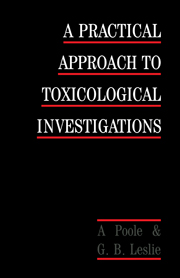Book contents
- Frontmatter
- Contents
- Foreword
- Preface
- List of abbreviations
- 1 Introduction
- 2 Regulatory requirements
- 3 Animals: sources, selection, husbandry
- 4 Standard studies in animals
- 5 Measurements and observations made in living animals
- 6 Terminal studies
- 7 Specialised routes of exposure
- 8 Reproductive toxicology
- 9 Genotoxicity
- Appendix 1 Toxicology data requirements for clinical trial approval and registration of new drugs
- Appendix 2 Countries and addresses of regulatory agencies
- Index
8 - Reproductive toxicology
Published online by Cambridge University Press: 04 August 2010
- Frontmatter
- Contents
- Foreword
- Preface
- List of abbreviations
- 1 Introduction
- 2 Regulatory requirements
- 3 Animals: sources, selection, husbandry
- 4 Standard studies in animals
- 5 Measurements and observations made in living animals
- 6 Terminal studies
- 7 Specialised routes of exposure
- 8 Reproductive toxicology
- 9 Genotoxicity
- Appendix 1 Toxicology data requirements for clinical trial approval and registration of new drugs
- Appendix 2 Countries and addresses of regulatory agencies
- Index
Summary
The ability of chemicals to produce foetal abnormalities has been known for some years, but such effects were considered unlikely to be produced at therapeutic dose levels of drugs. The fallacy of this belief was sadly demonstrated by the thalidomide tragedy, when it became evident that agents lacking ‘toxicity’ in toxicological studies could still possess marked teratogenic properties (i.e. capable of causing birth defects). Regulatory authorities and pharmaceutical companies were then faced with a problem which required prompt action to ensure other embryo and/or foetal toxic materials were not used in the human population. Since the studies then in use were inadequate for detecting potential developmental toxicants it became necessary to introduce methods to detect those agents capable of affecting normal reproductive processes.
There was some criticism that, to begin with, the major focus of attention was on the detection of malformations (teratology), with less regard being paid to other aspects of reproductive toxicity. In later years, however, reproductive studies have been designed to study not only teratological potential, but also gametogenesis (in both sexes), mating behaviour and performance, fertilisation, implantation and embryogenesis. The length of gestation, parturition, lactation, weaning, maternal care and a variety of postnatal effects, including growth, learning ability, reproductive capacity, etc., are also examined. (Because of the ongoing debate concerning the use of different terminologies in reproductive toxicology, the authors have attempted to use only a limited number of terms in a simplified context.)
TYPES OF STUDY
The FDA in the United States was the first regulatory authority to issue specific guidelines designed to evaluate new pharmaceutical preparations for reproductive toxicology.
- Type
- Chapter
- Information
- A Practical Approach to Toxicological Investigations , pp. 118 - 135Publisher: Cambridge University PressPrint publication year: 1989



